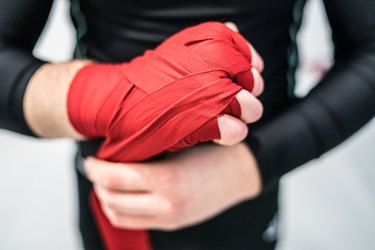
Boxing is a great cardiovascular workout — you can also burn up to 900 calories in just 30 minutes of intense boxing, turning you into a fat-burning, muscle-gaining machine. And it also happens to be a fantastic stress-relieving workout. There's just something so therapeutic about punching something to release pent-up aggression.
Before you jump into the ring with just a set of boxing gloves, though, you first need to protect your hands with boxing wraps to prevent a serious injury.
Video of the Day
Video of the Day
Why Use Boxing Wraps?
The most common injury, known as "boxer's knuckle," is a tear in the saggital band (crosses near your knuckle) and affects the middle and little fingers. Caused by repetitive blows, it requires surgery to fix, especially if you want to continue boxing.
The best way to avoid injury and potential surgery? Protect your hands. Doug Ward, director of marketing at equipment retailer Title Boxing, stresses not only the importance of using boxing wraps but also using them correctly.
"A properly applied wrap maintains the proper separation and configuration of the hand so that bones don't move, separate or come together on contact. They also provide an additional layer of cushion for impact." Not only that, they also aid in wrist stabilization, especially important for beginners who are still learning the proper way to punch.
There are a variety of lengths of hand wraps for boxing. But in order to get a fully padded wrap, look for a 180-inch length. Some stores will sell a 120-inch length, but they are too small for adults and don't provide sufficient protection.

What's the Best Material for Boxing Wraps?
Wrapping your hands, whether it's for boxing or mixed martial arts, is far superior to using gloves to protect your hands. And while some do like the gel hand wrap — it does excel in impact absorption — its protective properties are negated if you're throwing punches hard enough that would require more padding to prevent injury.
Instead, Ward recommends a spandex and polyester blend because it absorbs sweat, conforms to the shape of your hands and allows you to make a fist properly.
What's the Correct Way to Wrap Your Hands?
The main thing to remember when it comes to wrapping your hands is fit, says Ward. The goal is to make the wrap tight enough to maintain separation of all of the bones in your hands, but not so tight that it creates discomfort or you can't properly form a fist.
"Make sure to use a criss-cross pattern over the back of your hand, go between each finger and secure the back of the hand," he says. Glenn Holmes, head trainer at Box 'N Burn in Los Angeles agrees, adding, "The wrap should never be too tight or too loose with creases or gaps. It should fit nice and snug with the goal to protect the wrist, thumb, and knuckles."
The way you wrap your hands comes down to personal preference — there are a variety of ways to successfully protect your hands, knuckles and wrists. But if you're just beginning to box and want to make sure you're wrapping your hands correctly, check out the steps below.
How to Wrap Your Hands With Boxing Gloves
- Unroll the wrap to expose the thumb loop.
- Slide your thumb into the loop and wrap the material across the back of your hand.
- Wrap the material around your knuckles three times.
- Cross to the back of your hand and wrap your wrist with the material three times.
- Cross back to your palm and slide the material between your thumb and forefinger.
- Go back over your palm and loop around your thumb in the opposite direction.
- Wrap the material around your wrist, and then wrap between each finger, beginning between your pinky and ring finger.
- After the fingers are wrapped, wrap your knuckles three more times.
- Cross back to your wrist and wrap your wrist three more times.
- Finish and secure the wrap to your wrist with the closure.
Remember, you don't want a wrap that's too long with a lot of excess material or too short that doesn't provide adequate protection for your hands. A 180-inch wrap is the most common and provides the most protection against injuries.